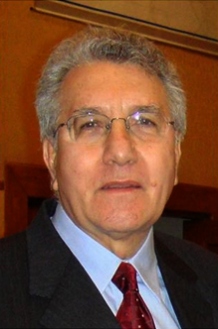Prof. Dr. Edwaldo Eduardo Camargo
.

Dr. Edwaldo Eduardo Camargo was born May 28, 1938, in Guaxupé, Brazil. He married Mrs. Elba Neisa Sá de Camargo in 1967 and had three children: Elba Cristina, Eduardo Felipe and Érica Cristina.
At the University of Sao Paulo, Brazil, Dr. Camargo earned his medical degree in 1964 and completed Internal Medicine Residency in 1966. He fell in love with Nuclear Medicine that same year and defended his thesis in Renal Scintigraphy in 1971. Because there were no Residency Programs in Nuclear Medicine in Brazil, in 1973 Dr. Camargo became a fellow in Nuclear Medicine at the Johns Hopkins University under Dr. Henry Wagner’s supervision.
In 1974 Dr. Camargo, in collaboration with Dr. Steven Larson, won 3rd prize on a study regarding the detection of metabolic activity of Mycobacterium leprae at the 1st Nuclear Medicine World Congress in Tokio. In 1977 Dr. Camargo became assistant professor of the Nuclear Medicine Division at the Johns Hopkins University.
Between 1982 and 1988 Dr. Camargo returned to Brazil as Head of the Nuclear Medicine Division of the University of Sao Paulo and of the Cardiac Institute of the University of Sao Paulo (INCOR) where he implemented Nuclear Cardiology. As radioisotopes were not easily accessible in Brazil, Dr. Camargo developed in the Nuclear Medicine Division of the University of Sao Paulo the preparation and nationwide distribution of radioisotopes, especially thallium-201 and gallium-67. Furthermore, he implemented the BACTEC technique (developed at Johns Hopkins University) and made it commercially available throughout Brazil. During his 6 years in Brazil he also created the Nuclear Medicine Residency program at the University of Sao Paulo and organized 12 Nuclear Medicine Meetings across the country to promote continuing education in Nuclear Medicine.
Between 1988 and 1991, Dr. Camargo returned to Johns Hopkins University as Full Professor of Radiology, Associate Director and Clinical Director of the Division of Nuclear Medicine.
He finally returned to Brazil as Head of the Department of Radiology at the Campinas State University (UNICAMP) where he implemented in the Nuclear Medicine Division, SPECT cameras, an in vitro laboratory, the second Nuclear Medicine Residency Program in the country and routine image transmition to other cities and states in Brazil. He also modernized the Radiology Division. In 1999 the first 18F-FDG image in Brazil was acquired at UNICAMP on a dual-head high-energy SPECT camera.
In 2002 Dr. Camargo became Head of the Nuclear Medicine Department at Sírio Libanês Hospital in São Paulo, where the first 18F-FDG PET/CT image in Latin America was acquired.
Dr. Camargo became President of the Brazilian Society of Nuclear Medicine (1992 to 1996) and President of the Latin American Society of Nuclear Medicine (ALASBIMN) (1996 -1997).
On the occasion of homage for his retirement from the University of Campinas (UNICAMP) for all his accomplishments, Dr. Camargo said "I do not deserve this homage. I only did what had to be done". A phrase that demonstrates his humbleness and resiliency in face of the immeasurable contribution and legacy he left for Nuclear Medicine in Brazil. Over the years Dr. Camargo wrote over 35 book chapters and published more than 385 papers.
Dr. Camargo died on Friday, March 4, 2016. He was admired by his colleagues in Brazil and in other parts of the world. One of Dr. Camargo’s former residents wrote a note after his death: “ To be a teacher it is not enough to want to be a teacher... you have to be born a teacher.... you have to inspire in people feelings that they would never discover alone ... the greatest one is the pleasure of studying...“
Elba Camargo
